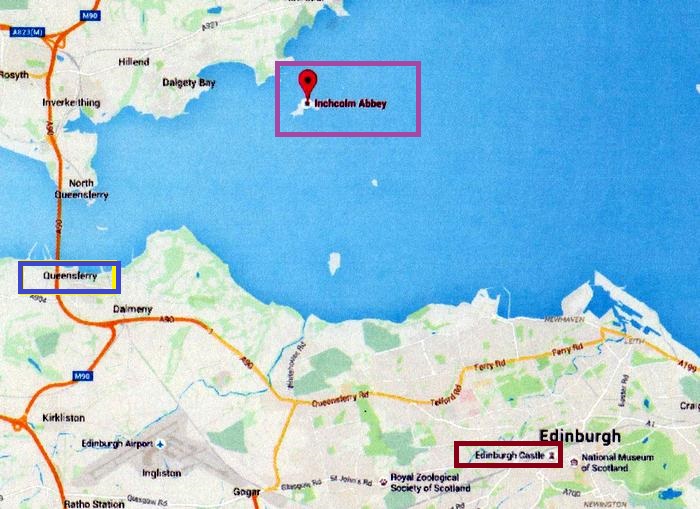CATHEDRAL QUEST
Our quest to experience the great cathedrals and churches of Europe
U.K. 2013
EDINBURGH
DAY 3 Thursday SEPT 5
After another delicious breakfast, we took a taxi across town to meet a 10:15 tour bus to the Firth of Forth for a boat ride. We were a little concerned about the weather as it looked as if it might rain. It was rather cool and my red sweater and jacket felt good.
The starting point for the boat ride was next to the Red Train Bridge.
The boat had a large glassed in area as well as open front and rear decks. We stayed inside for a while and then got brave and went on the front deck.
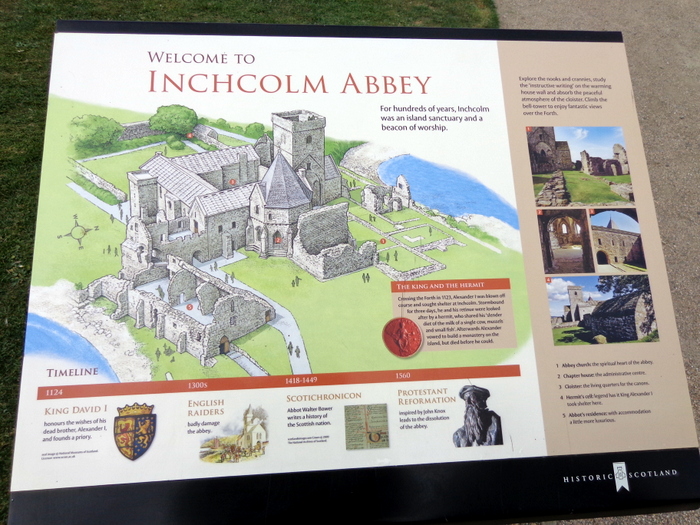 INCHCOLM
ABBEY
INCHCOLM
ABBEY
Our one stop was Inchcolm Island for an extra fee. The boat let those who wanted to explore the island off for 1 ˝ hours, and would pick us up on the next time around. The only structure, except the gift shop, on the island are the ruins of an Abbey.
The origins of the Christian presence on Inchcolm are not recorded.
However, it is thought that the island may have been the site of an
early hermitage. In his biography of St. Margaret, written in the early
1100s, Bishop Turgot of St. Andrews tells of the great number of hermits
who lived saintly lives in isolated cells throughout Scotland.
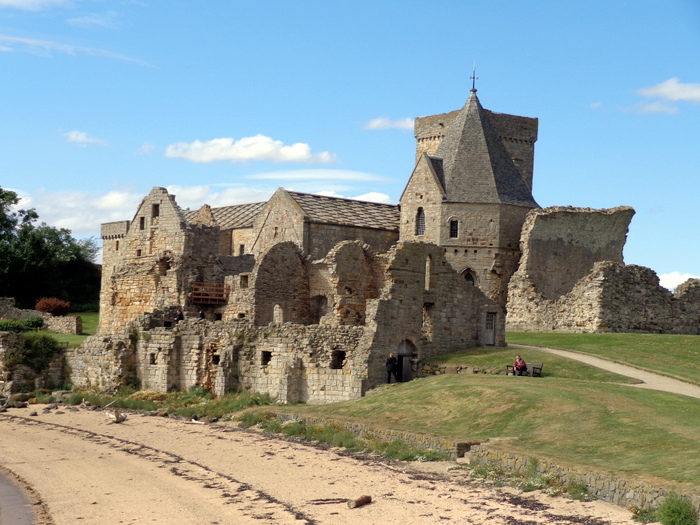 The
hermits who successively inhabited this island were guardians of holy
places whose reputation went back several centuries to the equally
shadowy figure of St. Colm. "His name is enshrined in the island's name
–"inch" is derived from the Gaelic innis, meaning island. Nothing is
known of Colm himself. He is not included in the Oxford Dictionary of
Saints.
The
hermits who successively inhabited this island were guardians of holy
places whose reputation went back several centuries to the equally
shadowy figure of St. Colm. "His name is enshrined in the island's name
–"inch" is derived from the Gaelic innis, meaning island. Nothing is
known of Colm himself. He is not included in the Oxford Dictionary of
Saints.
The Monastery was first establish as a priory in the 1100s and elevated to
Abbey status in 1235. In the 1300s, it was repeatedly raided by the
English. Following the Protestant Reformation, the community was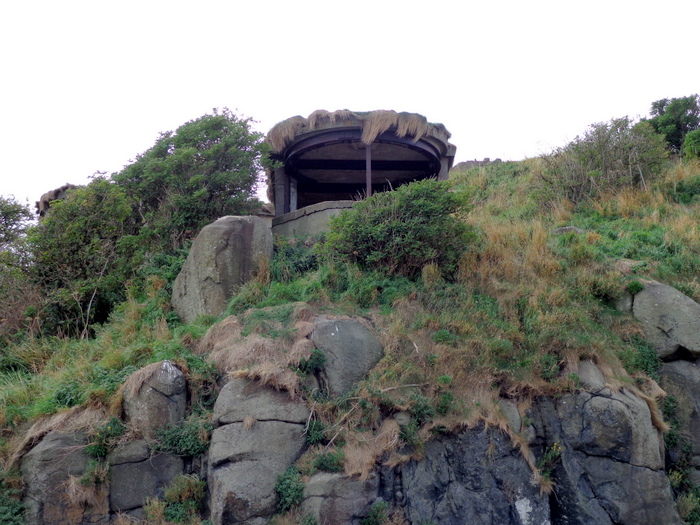 disbanded. The church was partially dismantled and afterward used as a
private house. In later years, Incholm served as a quarantine island for
plague stricken ships and as a hospital during the Napoleonic wars.
disbanded. The church was partially dismantled and afterward used as a
private house. In later years, Incholm served as a quarantine island for
plague stricken ships and as a hospital during the Napoleonic wars.
Installations built to defend the Forth during the two World Wars can still be seen on the island.
The exploration of the abbey was fascinating. Most of
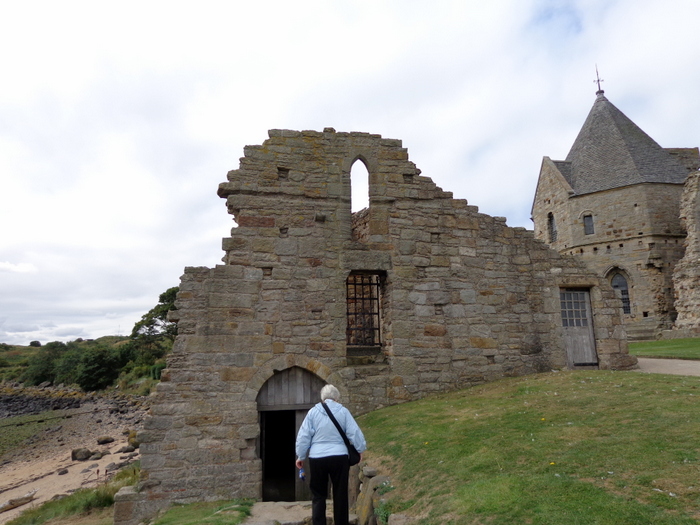 buildings are only
partially standing. The lower building known as the Abbott's house,
had the appearance of a long tunnel. It was thought that this had been
an infirmary at one time.
buildings are only
partially standing. The lower building known as the Abbott's house,
had the appearance of a long tunnel. It was thought that this had been
an infirmary at one time.
We came out at the opposite end near a door that contained a rather steep circular stairway.
Kathleen decided that she would just wait while I explored what was up the stairway.
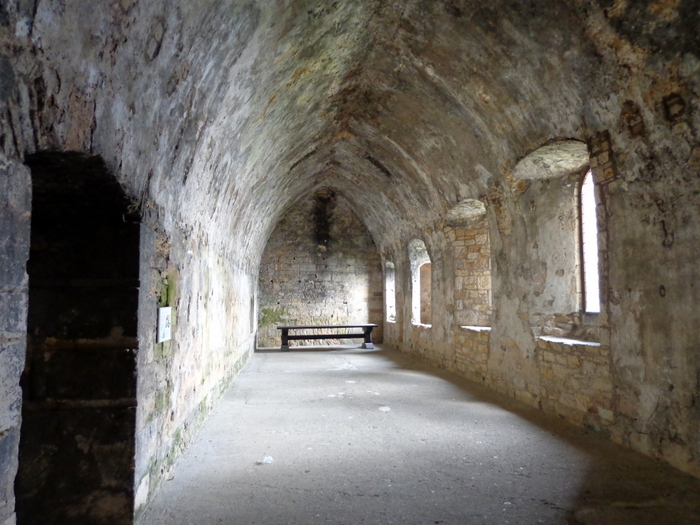 There was a long room which was the refectory.
There was a long room which was the refectory.
Nearby was a room with an arched fireplace which was the kitchen. Exploring a little further was a view of the remains of the 15th century church.
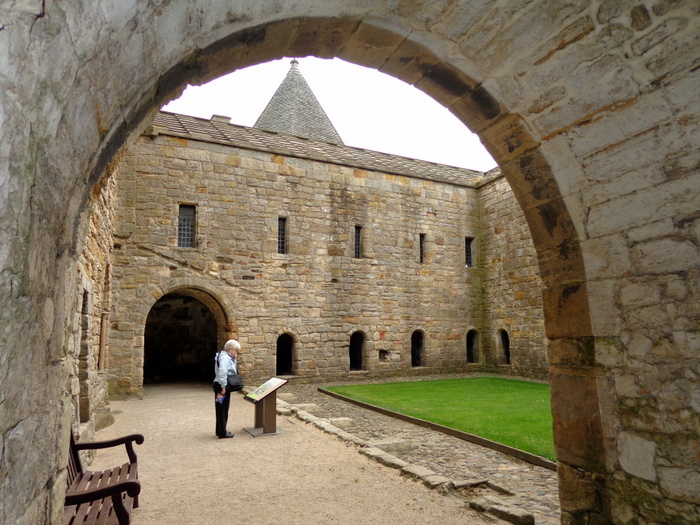 After finding my way
back down, Kathleen and I walked into the cloister which is reported to
be the best preserved medieval cloister in Scotland. The upper level of
the cloister contained the dormitories.
After finding my way
back down, Kathleen and I walked into the cloister which is reported to
be the best preserved medieval cloister in Scotland. The upper level of
the cloister contained the dormitories.
Next we visited the chapter house which was on the east side of the
clo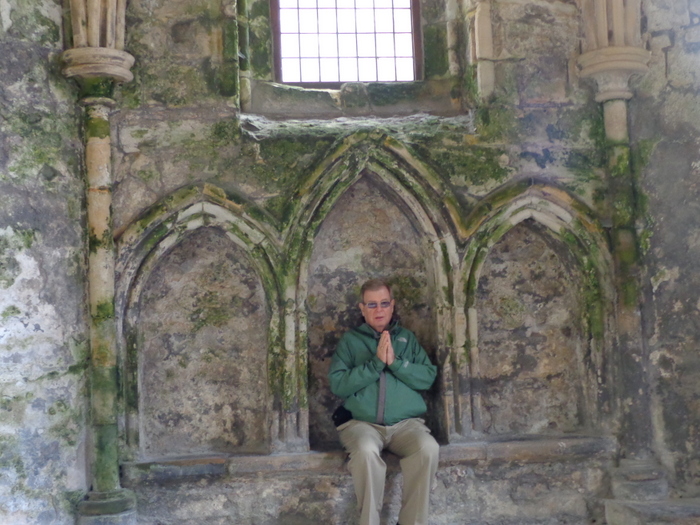 ister. This is where the Abby's business was conducted. It is an
octagonal building with a tall pointed roof and is the only surviving
cloister building that dates from the 1200s. The focus of the room is
the three seats on the east wall for the three principal office bears:
the Abbott, Pryor, and the sub-prior. The remaining cannons sat on
stone benches around the wall. Please note in the photograph the Abbott
who is presently presiding.
ister. This is where the Abby's business was conducted. It is an
octagonal building with a tall pointed roof and is the only surviving
cloister building that dates from the 1200s. The focus of the room is
the three seats on the east wall for the three principal office bears:
the Abbott, Pryor, and the sub-prior. The remaining cannons sat on
stone benches around the wall. Please note in the photograph the Abbott
who is presently presiding.
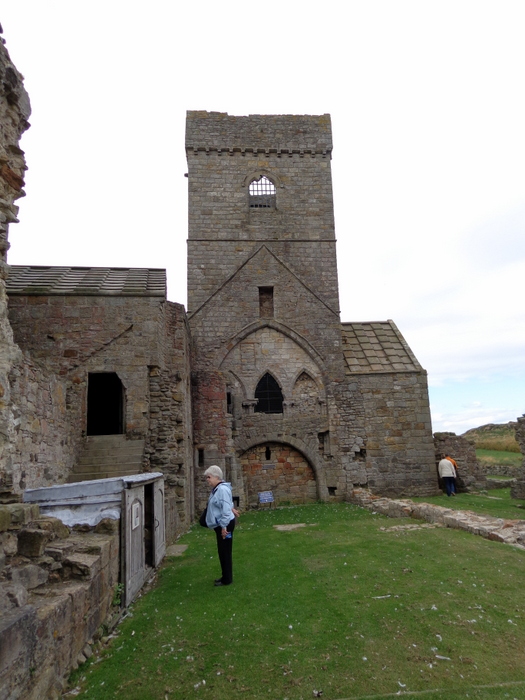 There are parts of the first church built in the 12th century still
standing including the Bell tower and the nave. The footprint of the
15th century church was clearly defined and well marked.
There are parts of the first church built in the 12th century still
standing including the Bell tower and the nave. The footprint of the
15th century church was clearly defined and well marked.
After this fascinating visit, we went to the gift shop where we found
several light snacks, souvenirs and a beautiful book about the Abby. At
1:45
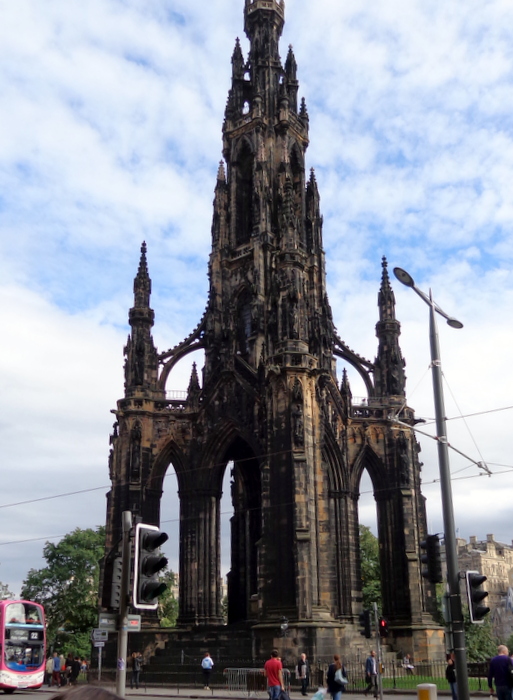 the boat came back and took us back to the starting point in town
at the Red Bridge. The bus was waiting for us. The bus had an audio
system which pointed out significant buildings going and coming back.
the boat came back and took us back to the starting point in town
at the Red Bridge. The bus was waiting for us. The bus had an audio
system which pointed out significant buildings going and coming back.
It was after 5:00 when walked back to the hotel. We walked past Scott Monument which is a Victorian Gothic structure honoring the Scottish author, Sir Walter Scott. It is the largest monument to a writer in the world, reaching a height of 200'6". It has a series of viewing platforms. The highest platform is reached by a total of 287 steps. We did not venture going up into the tower.
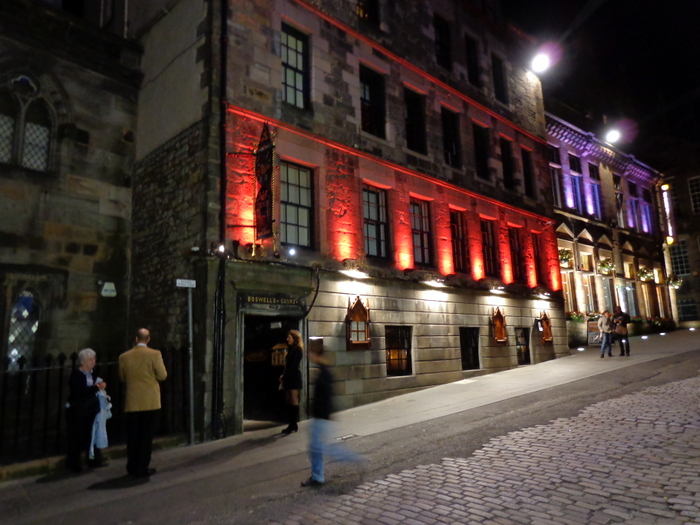 After a little rest, we took a taxi back up to the castle area to a famous
restaurant known as the Witchery. We have had reservations for a long
time. It was very quaint and attractive. I had my first scotch on
After a little rest, we took a taxi back up to the castle area to a famous
restaurant known as the Witchery. We have had reservations for a long
time. It was very quaint and attractive. I had my first scotch on
the rocks. It wasn’t too bad but not as good as Jim Beam or Jack Daniel. We began with 3 each oysters on the half shell. We each had one from Landisfarne and two local. Kathleen had duck, and I had scallops with mashed potatoes and salad for dinner. We shared a bottle ofChablis from Beaune, France where we visited last year. For dessert we shared a chocolate tart with orange ice cream. It was a wonderful dinner and a lovely place. We highly recommend it and suggest very early reservations before you leave home. There were no electric lights turned on in the dining room….all candle light. We took a taxi back to our hotel.
NEXT DAY
PREFACE
Day 1 -Arrival in Edinburgh
Day
2 - Edinburgh
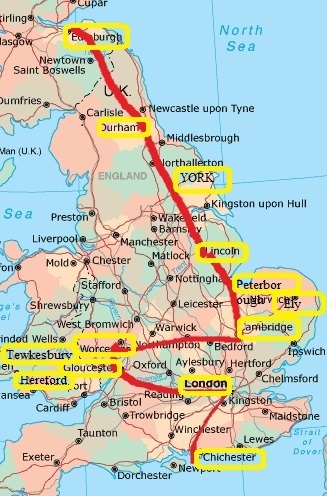
Day 3- Edinburgh to Inchcolm Abbey
Day 4 - Edinburgh to Melrose & Rosslyn
DAY 5 - Edinburgh
DAY 6 - Edinburgh
DAY 7 - York
DAY 8 - Durham
DAY 9 -York
DAY 10 - Lincoln
DAY 11 -Ely
DAY 12 - Peterborough
DAY 13 - Cambridge
DAY 14 - Ely to Worchester
DAY 15 - Tewkesbury and Gloucester
DAY 16 - Hereford
DAY l7 - London
DAY 18 - London
DAY 19 - London
DAY 20 - London to Guildford, Chichester, Midhurst
DAY 21 - London OUR LAST DAY
HOME

